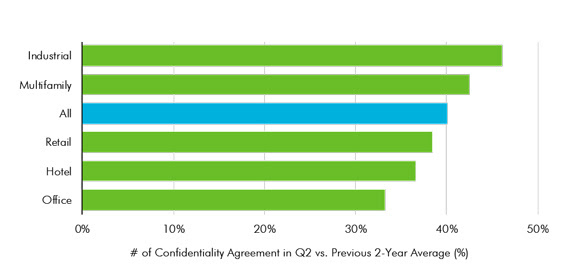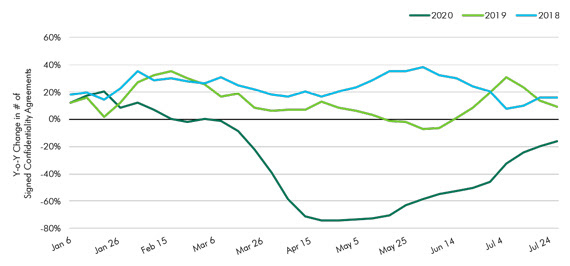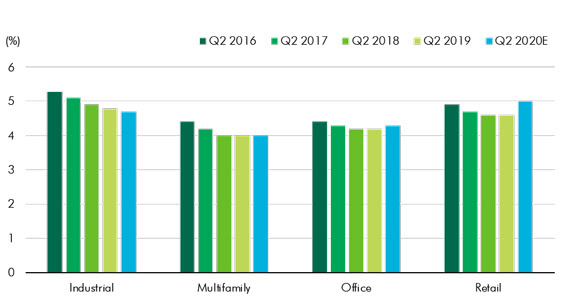The WPJ
THE WORLD PROPERTY JOURNALReal Estate Facts Not Fiction
Commercial Real Estate News

Commercial Investor Activity in U.S. Rebounding from Q2 Coronavirus Low
Commercial News » Los Angeles Edition | By Michael Gerrity | August 14, 2020 9:01 AM ET
According to global commercial real estate consultant CBRE, U.S. commercial investor sentiment and transaction activity are recovering from the depths of the COVID-19 crisis.
CBRE is further reporting that at the end of July 2020, the number of signed confidentiality agreements was down by only 17% year-over-year--a marked improvement from the 74% drop-off in April and May 2020. This measure of revived investor interest could be a harbinger of a future rebound in commercial real estate transaction volume.
Signed confidentiality agreements in Q2 2020 for industrial and multifamily property offerings reached 46% and 42%, respectively, of the past two years' average Q2 level. Lockdown measures due to COVID-19 have spurred higher e-commerce growth, particularly online grocery shopping. Expansion of supply chains and retailers' omnichannel presence will propel continued demand for logistics facilities and warehouses.
COVID health concerns and the potential for companies to more enthusiastically embrace remote-working arrangements have weakened the rental outlook for some office properties. Operational office assets, such as life sciences facilities, data centers and single-tenant buildings, are more resistant to downturn risks and offer investors income stability. The rising popularity of operational office has buoyed total transaction levels and led to a material pick-up in the average price per sq. ft. of property sales.
Many investors are requesting price reductions, says CBRE. Property values are expected to decline 10% to 20% by year's end, causing a moderate rise in cap rates. While this trend was not fully manifested in Q2 2020 due to limited transaction activity, July sales indicate cap rates of Class-A industrial and multifamily assets were more stable in Q2 compared with other asset types.
Looking ahead, CBRE predicts an eventual recovery of transaction activity will be led by value-add investors with abundant capital and risk-averse investors seeking an alternative to low-yielding bonds, allowing cap rates to return to pre-COVID levels within three years.
CBRE is further reporting that at the end of July 2020, the number of signed confidentiality agreements was down by only 17% year-over-year--a marked improvement from the 74% drop-off in April and May 2020. This measure of revived investor interest could be a harbinger of a future rebound in commercial real estate transaction volume.
Signed confidentiality agreements in Q2 2020 for industrial and multifamily property offerings reached 46% and 42%, respectively, of the past two years' average Q2 level. Lockdown measures due to COVID-19 have spurred higher e-commerce growth, particularly online grocery shopping. Expansion of supply chains and retailers' omnichannel presence will propel continued demand for logistics facilities and warehouses.
COVID health concerns and the potential for companies to more enthusiastically embrace remote-working arrangements have weakened the rental outlook for some office properties. Operational office assets, such as life sciences facilities, data centers and single-tenant buildings, are more resistant to downturn risks and offer investors income stability. The rising popularity of operational office has buoyed total transaction levels and led to a material pick-up in the average price per sq. ft. of property sales.
Many investors are requesting price reductions, says CBRE. Property values are expected to decline 10% to 20% by year's end, causing a moderate rise in cap rates. While this trend was not fully manifested in Q2 2020 due to limited transaction activity, July sales indicate cap rates of Class-A industrial and multifamily assets were more stable in Q2 compared with other asset types.
Looking ahead, CBRE predicts an eventual recovery of transaction activity will be led by value-add investors with abundant capital and risk-averse investors seeking an alternative to low-yielding bonds, allowing cap rates to return to pre-COVID levels within three years.

Sign Up Free | The WPJ Weekly Newsletter
Relevant real estate news.
Actionable market intelligence.
Right to your inbox every week.
Real Estate Listings Showcase
Related News Stories
Commercial Real Estate Headlines
- One Trillion Dollars of America's Commercial Property Loans Mature in 2025
- U.S. West Coast Dominates Self Storage Demand
- Phoenix, Orange County and Inland Empire Emerge as Leading U.S. Industrial Markets
- U.S. Mega Distribution Centers Leasing Activity Grew in 2024
- U.S. Commercial Borrowing to Increase to $583 Billion in 2025, Up 16 Percent Annually
- Demand for U.S. Life Sciences Space Spikes 28 Percent Annually in Late 2024
- Multifamily Property Sector in America Rebounding
- Asia Pacific Commercial Property Investment Spikes 23 Percent in 2024
- U.S. Commercial Property Market Primed for Growth in 2025
- Architecture Industry Sees Mixed Signals as 2025 Approaches
- Global Data Center Demand Spikes in 2025
- 2025 Prediction: U.S. Commercial Investment Recovery Expected to Gain Traction
- Holiday Retail Sales for 2024 to Hit Record $1 Trillion
- Tech, AI Industries Drive Largest Share of Office Leasing Activity in U.S.
- Commercial Real Estate Lending in U.S. Enjoys Strong Growth in Q3
- U.S. Multifamily Market Begins Recovery in Q3
- Commercial Investment in Japan Spikes 24 Percent Annually in Q3
- Despite Return-to-Office Mandates, U.S. Office Vacancies Continue to Rise
- PROPSIG Tech Startup Acquired by World Property Data
- U.S. Commercial Mortgage Debt Hits $4.7 Trillion in Q2 as Delinquencies Increase
- Hong Kong Class A Office Rents Continue to Downtick in Mid-Summer
- U.S. Office Landlords Tenant Concessions Decline for First Time in 4 Years
- U.S. Commercial Mortgage Originations Spike 27 Percent in Q2 Over Q1
- Phnom Penh's Commercial Office, Retail Markets Face Slowdowns in 2024
- Global Edge Data Center Market to Hit $300 Billion by 2026
- Commercial Property Transactions in Japan Dive 25 Percent Annually in Q2
- Delinquency Rates for U.S. Commercial Property Loans Downticks in Q2
- Megawarehouse Lease Deals in U.S. Increase in 2024
- Office Tenants' Flight to Quality Buildings Increases in 2024
- Commercial Lending in Japan Upticks 6 Percent Annually in Q1
- AI Driving Significant Global Data Center Growth in 2024
- Total U.S. Commercial Mortgage Debt Rises to $4.7 Trillion in Q1
- U.S. Commercial Mortgage Delinquencies Rise in Early 2024
- Asia Pacific Office Sector to Further Reprice Throughout 2024
- U.S. Retail Foot Traffic to Surpass Pre-Pandemic Levels by 2025
- Commercial Real Estate Lending in U.S. Slowed in First Quarter
- Japan Commercial Property Investment Volume Jumps 7 Percent in Q1
- Asia Pacific Commercial Property Investment Leads the World, Spikes 13 Percent
- Driven by High Rates, U.S. Commercial Lending Imploded 47 Percent in 2023
- After Two Year Slump, Prime Multifamily Metrics Uptick in U.S.
Reader Poll
Marketplace Links
This website uses cookies to improve user experience. By using our website you consent in accordance with our Cookie Policy. Read More







